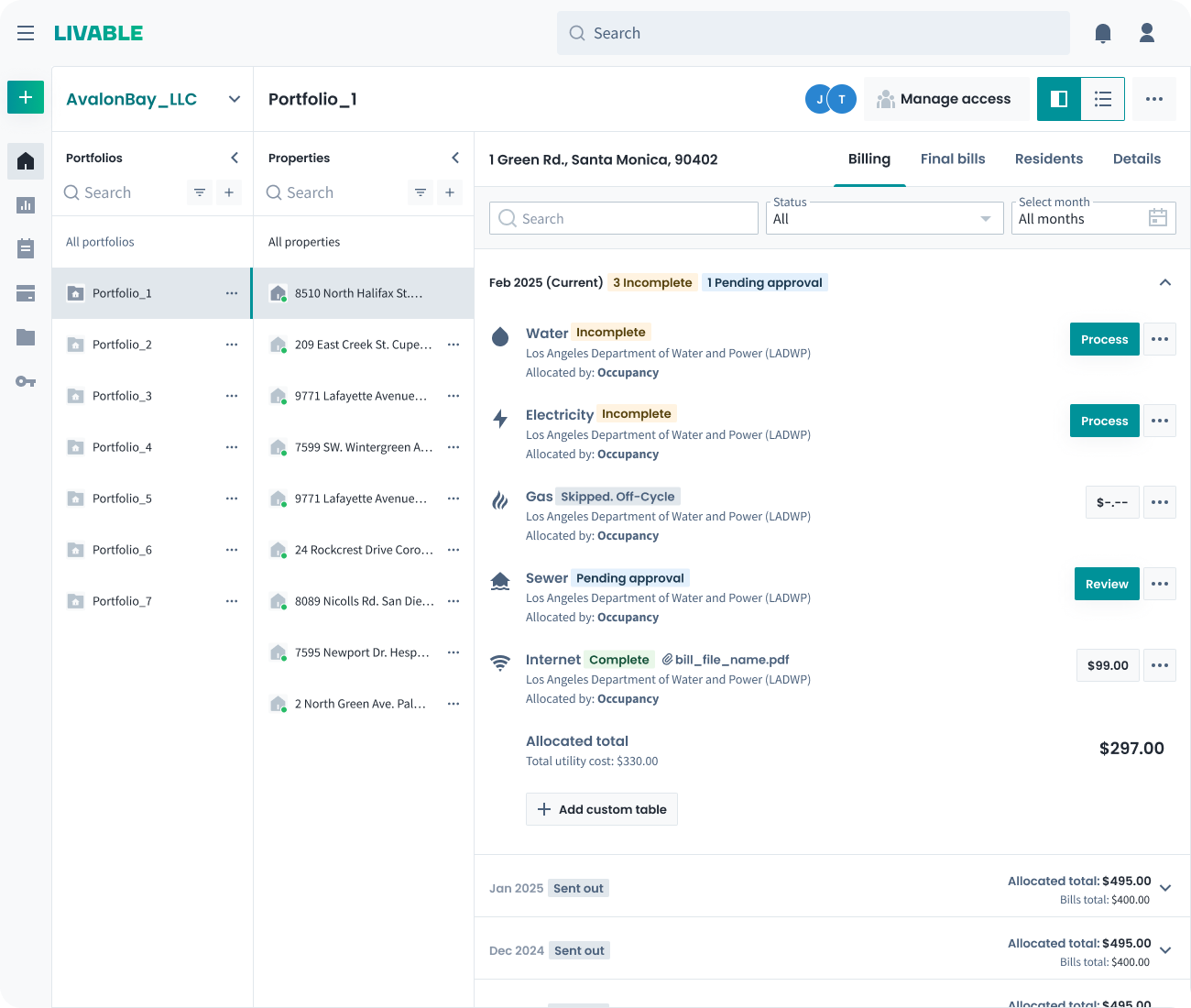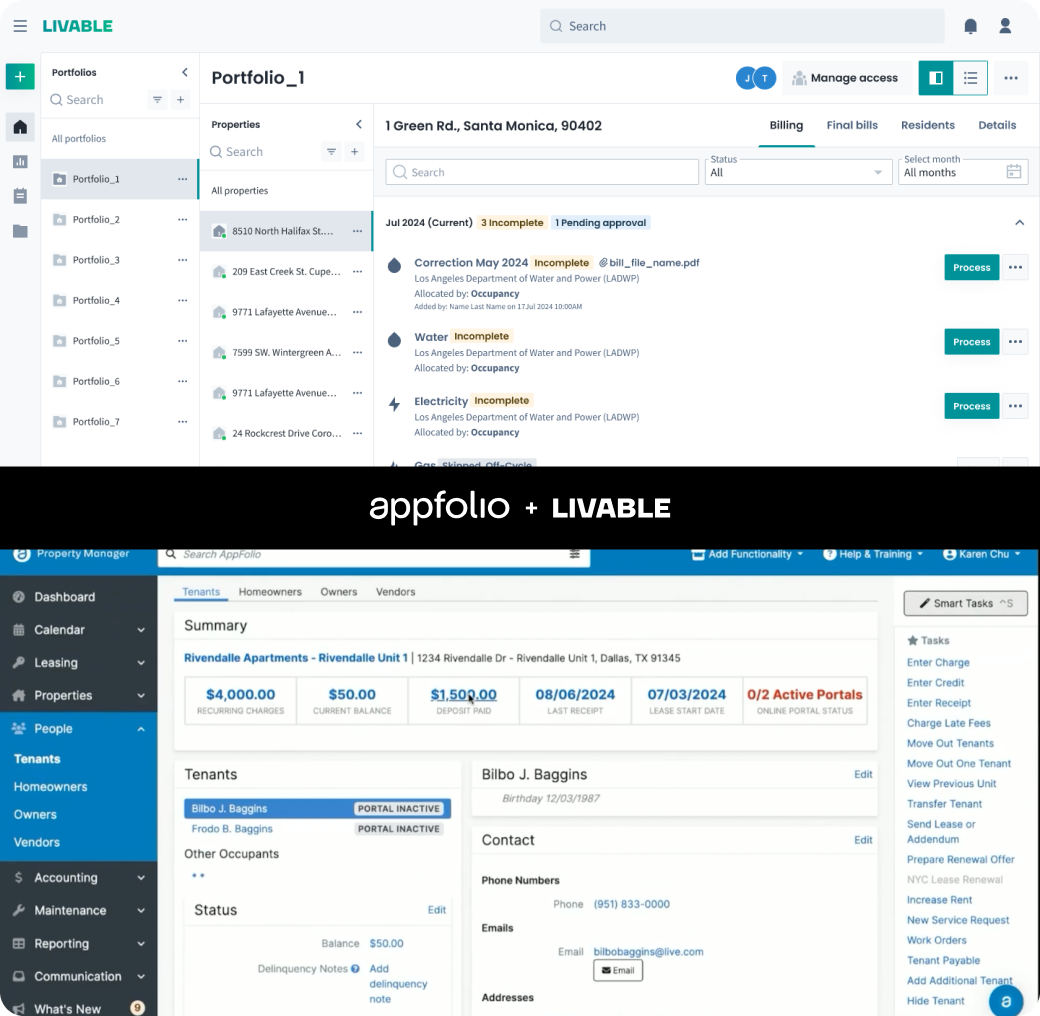Less Waste, More Profits for AAGLA Members


Recover Up to 90% of Your Utilities with Livable
If you're tired of including utilities with your rent every month, and chipping away at your net operating income, Livable helps put money back in your pocket, while promoting conservation.
- It works with or without rent-controlled buildings - note that there are some limitations in rent stabilized markets.
- Livable saves you money with no unit minimums - ever!
- Bill back for water, sewer, trash and more.
- Livable Pro is so easy you can manage it yourself!
- Prefer to set and forget? Delegate to Livable by upgrading to Billing Automation!
"Livable is an amazing, simple-to-use platform that saves property owners money while also conserving precious resources like water. Many of our members today are using Livable’s highly-rated Ratio Utility Billing System and are realizing savings on all their utility bills. I am impressed by how easily our members have deployed the Livable ‘RUBS’ platform and how quickly they have begun saving on their utility bills."
 David Cordero
Apartment Association of Greater Los Angeles
Executive Director
David Cordero
Apartment Association of Greater Los Angeles
Executive Director
Did you know...
Water Utility Rates are Rising
Across the country, water utility rates are steadily climbing year over year. A combination of aging systems, fewer resources, and extreme weather have pushed water and wastewater bills up by 30% in less than a decade.
Save Money, and the World
Studies show that individually calculated utility bills can reduce water, gas, and electricity usage by up to 35%. When tenants see a direct connection between their consumption and their costs, they’re more likely to conserve—benefiting both the environment and your bottom line.
But You Can Divide and Conquer
A well-executed Ratio Utility Billing System (RUBS) fairly distributes utility costs (water, sewer, trash) among tenants in buildings without individual utility meters. Our system allocates expenses based on factors like unit size, number of occupants, or a combination of variables—ensuring tenants share utility costs proportionally and equitably.

Ratio Utility Billing in Your State
The California Public Utilities Commission (CPUC) regulates privately owned utilities (electric, gas, water, sewer) but not public/municipal utilities like SMUD or the Los Angeles Department of Water and Power.
CPUC oversees natural gas services for 10.8 million customers, including those served by Pacific Gas and Electric, Southern California Gas, San Diego Gas & Electric, and Southwest Gas.
Water regulation in California is complex, involving state, county, and city authorities. CPUC governs only a small portion of privately owned water utilities, so local authorities should be consulted for property-specific rules.
California Senate Bill 7 (SB7), effective January 1, 2018, mandates water submetering in all new multi-family residences to promote conservation and consumer protection. Additional regulations may be imposed if they match or exceed the current law. See Article 5, Section 537.3(c) of SB7 for details.
Disclaimer: Utility cost recovery laws (Ratio Utility Billing) frequently change. While we strive to keep our data updated, we do not guarantee accuracy at all times. This information is for educational purposes only and does not constitute legal advice or warranties regarding regulatory compliance.
- Tenant Billing: The law doesn’t specify anything about ratio utility billing systems.
- Regulations: The MPSC doesn't oversee water/wastewater. No known state regulations specifically address RUBs for water/wastewater, but local regulations might. Always consult local jurisdictions for clarity.
-
Fees: The law doesn’t specify anything about ratio utility billing systems.
- Tenant Billing: The law doesn’t specify anything about ratio utility billing systems.
- Regulations: No specific rules from the MPSC were found regarding the use of RUBs for electricity. Check with local electrical providers to ensure compliance with their regulations.
- Fees: The law doesn’t specify anything about ratio utility billing systems.
- Tenant Billing: The law doesn’t specify anything about ratio utility billing systems.
- Regulations: The MPSC hasn't set any specific rules about RUBs for gas. It's advised to consult with local gas providers to verify any potential restrictions.
- Fees: The law doesn’t specify anything about ratio utility billing systems.
- Tenant Billing: The law doesn’t specify anything about ratio utility billing systems.
- Regulations: There are no specific rules about billing tenants for trash.
Interested in More Resources?
Livable Pro offers its users access to a library of helpful resources and documentation for Rental Owners and Property Managers. From resident notices to lease addenda, we support customers transitioning onto our platform and implementing RUBS for their Residents.*
What's New? Our AppFolio Integration
With tenant and manager portals sync'd, insights are on display, but you can also preview and modify billing as needed. No more waiting for an Account Manager to get back to you!
✓ Automatic turnover processing
✓ Custom tenant fees
✓ Utility & Statement caps
✓ Unit and resident level opt outs
✓ Final statement estimates with daily proration
✓ View, modify and approve charge batches
✓ Vacant unit cost recovery
On AppFolio and ready to integrate?


Our Features
Why Choose Livable?
1. No setup fees, no minimums, no handcuffs
Commit one or all of your properties, we're flexible.
2. Made for you
Our robust platform allows service to any portfolio, no matter how unique or custom the property.
3. Transparency and control
With tenant and manager portals, insights are on display, but you can also preview and modify billing as needed. No more waiting for an Account Manager to get back to you!
4. Easy to Use
There's no need to learn any new "tricks" to use Livable Pro. We kept it simple so you can get started right away.
How it Works
Setting Up Livable Pro is Quick & Easy
Add Your Properties & Residents
Adding properties is effortless. Import key data into Livable, then fine-tune settings directly in our system with our onboarding team. Easily configure unit and resident parameters, including opt-ins, fee customization, and more!
Add Your Utility Costs
Choose the option that works best for you: enter utility data manually with our self-serve billing engine, or upgrade to Billing Automation—where, for an additional monthly fee, we handle the work for you!
Start Saving Money
Livable calculates charges and then generates monthly statements issued directly to tenants. With more fair and accurate utility allocation, you’ll boost net operating income while reducing consumption!
Join thousands of housing providers and property managers
using Livable to offset rising utility costs
Livable benefited my business by offsetting utility expenses through pro rata distribution to the lessee's and during the process reduced water usage by 25%. I no longer have to worry about what the amount of the bill will be as the residents also have an interest in not wasting water.
Dennis R.
Livable was an excellent choice. Livable utility management offers a conscious responsibility to the owners and to the renters to ensure that the utility ratio billing is fair for both landlords and residents. Livable lives up to its simple program implementation. They are easy to connect with. I get immediate help if I need it. Thank you Livable.
Cara N.
Livable is an invaluable partner to our organization. For years in our rent-controlled city, the only way to increase the bottom line was through unit turnover. Utility costs increased by as much as 20%/yr, which directly impacted NOI. With Livable, we are able to not only recoup most of our utility costs but also are able to pass through future utility price increases.
Ryan S.
Come Save With Us!
With no unit minimums and coverage for water, sewer, trash and more—what are you waiting for? Sign up for Livable Pro today to start boosting your NOI. Prefer a hands-on approach? Manage it yourself with our easy-to-use system. More of a set-it-and-forget-it type? Enroll in Billing Automation, and we’ll handle everything for you!

.png?width=300&height=56&name=Livable%20Logo%20%20(2).png)